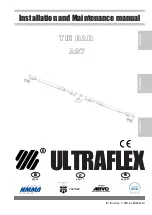
50 | Ottobock
E-MAG Active
NOTICE
Risk of joint bar breakage.
Do not set joint bars below a flexion radius of 15 mm. The joint bars must
not be subjected to heat treatment.
NOTICE
Risk of damage due to improper installation.
During adjustment, ensure that the bending radius is
not less than 15 mm to avoid the risk of breaking. Grind away surface imperfections such as grooves
and burrs caused during shaping.
INFORMATION
The only function of the casing is to protect and retain the battery, electronics and cable connections.
The casing only has to be large enough to enclose these components. However, individual patient
requirements should be taken into account:
The casing should be larger if padding is to be installed on the transfemoral socket. In that case, the
pad is glued directly onto the casing. Otherwise, the padding would have to be stripped and glued
every time a technician needs to access components that lie beneath.
Remove all dummies except for the E-MAG knee joint dummy and set up the system joint bars
as usual (Figure 17).
The bore holes in the system box of the knee joint make it possible to temporarily attach the
system joint bars with a screw while assembling the orthosis for fitting. The required threaded
bore in the system joint bar must be subsequently added (M4 screws).
Reinforce the orthosis according to the requirements of the patient profile up to the second-to-
last layer (Figure 18).
17
18
INFORMATION
Also read the Technical Information 646T5=9.1GB. The following languages are available: D, GB, F,
I, E, P, NL, S, PL, H, CZ. Please contact your national Ottobock branch.
Attach the lamination plates prior to the last stockinette layer and fasten them with small pieces of
carbon (Fig. 19).
Then pour and process the lamination resin. Once the resin is distributed without air
inclusions
, firmly
press the dummies onto their designated surfaces on the
PVA bag
.
Wrap the dummies with Vulkolan® tape in order to maintain pressure during hardening (Figure 20).















































